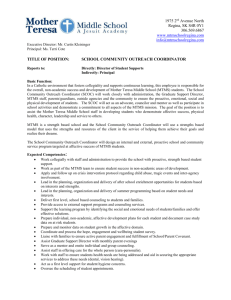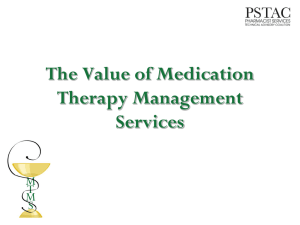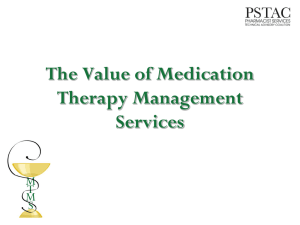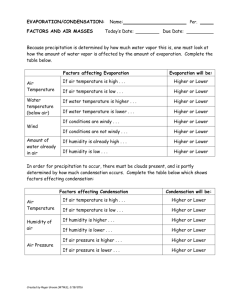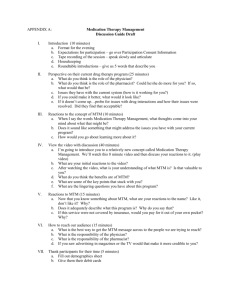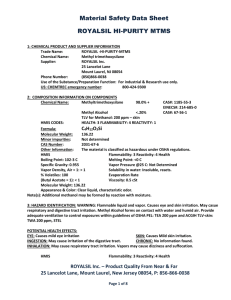Pharmacist Guidebook for MTMS Educational Tools
advertisement
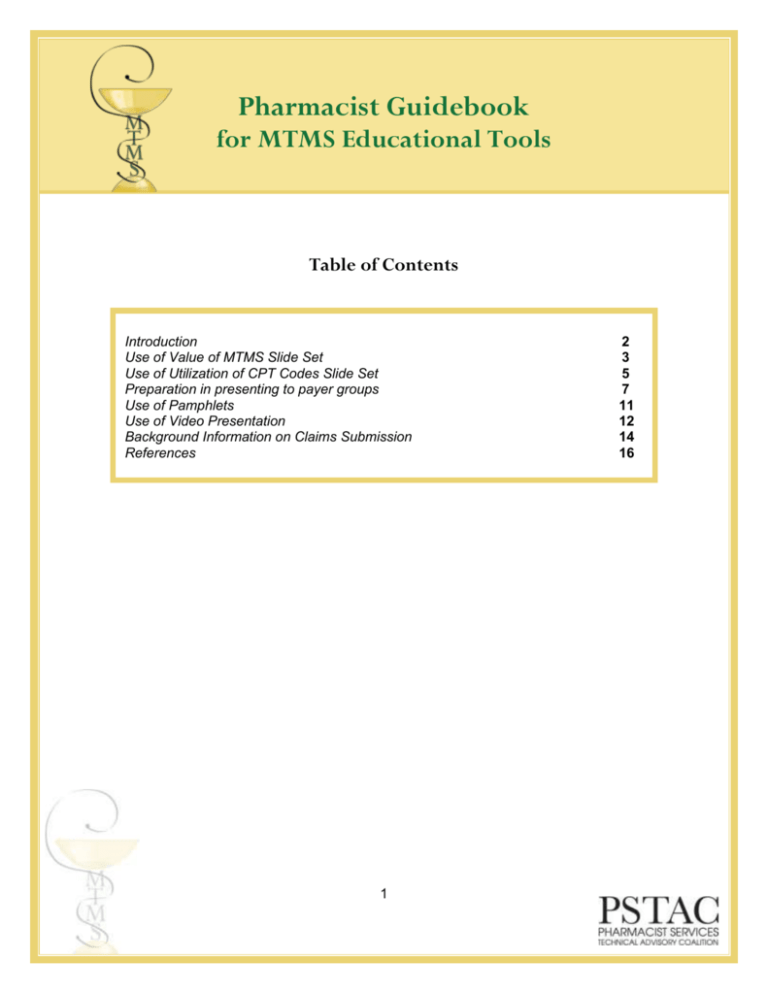
Pharmacist Guidebook for MTMS Educational Tools Table of Contents Introduction Use of Value of MTMS Slide Set Use of Utilization of CPT Codes Slide Set Preparation in presenting to payer groups Use of Pamphlets Use of Video Presentation Background Information on Claims Submission References 1 2 3 5 7 11 12 14 16 Introduction In this guidebook, we have included general direction on how to get the most benefit out of the materials included in this set of educational materials. We hope that these materials will be helpful for you, whether you are an experienced provider of medication therapy management services, or if you are brand new to the practice of MTMS. Recognition of MTMS is growing, but there are still only a limited number of payer groups covering this important health care service. Our goal is that by providing these materials directly to pharmacists across the country, we can see a grassroots movement in pharmacists encouraging payer groups to cover these services. These materials will help you in presenting MTMS to self-insured payer groups, health plans, or even directly to potential patients. If you are a new pharmacist in MTMS, it is important to recognize that you a part of national group of pharmacists offering these services. Connecting with your peer practitioners can be very helpful in achieving success. We encourage you to contact your state and national associations to get connected with other pharmacists offering MTMS. The American College of Clinical Pharmacy (ACCP) has a Practice and Research Network (PRN) dedicated specifically to ambulatory care. This Am-Care PRN is made up of over 1000 pharmacists across the country who are involved in MTM. Throughout these materials, we have consistently used the acronym “MTMS” for medication therapy management services. In the pharmacy community, you will often see the acronym “MTM” for medication therapy management. The CPT coding manual specifically refers to MTMS, which is why we have chosen to utilize that acronym throughout. These materials were developed as a result of a grant from the Pharmacist Services Technical Advisory Coalition (PSTAC). Materials were drafted by a core team including: Sarah Westberg, Pharm.D., BCPS, Amanda Brummel, Pharm.D., Ken Dickson, Pharm.D., Laura Odell, Pharm.D., CDE, Amy Pittenger, Pharm.D., M.S., and Julie Johnson, Pharm.D. All materials were reviewed by a series of 4 focus groups, including MTM practitioners and current/potential MTM payers. In addition, materials were reviewed by members of PSTAC before being finalized. 2 Use of Value of MTMS Slide Set This material is intended to be utilized when presenting to potential payer groups or other decision-making groups regarding MTMS. Intended audiences could include health plans, government agencies, employer groups, patient support groups, or individual patients willing to pay full price for the value of MTMS. In this guidebook, we have provided some advice on how to best use these slides based on the audience to which you are presenting. This slide set is provided in 5 versions. They are: Full slide set of 65 slides Key slides which could be used in a short, 10 minute presentation Key slides which could be used in a 30 minute presentation Key slides for presenting to an employer group Key slides for presenting to a health payer group or government agency The lower left-hand corner of the slides has been designated as a location in which you can place your institution’s logo. The full set of slides will likely be too lengthy for most presentation opportunities. Pharmacists are encouraged to use the full slide deck to choose slides most appropriate for your intended audience and for your MTMS practice. In the 10 minute and 30 minute presentation examples, we have done this for you. These presentations should be amenable to most payer audiences. In the full slide set, Slides 18, 19, and 22 have hyperlinks to video clips. Simply click on the picture when you’re in the presentation mode, and the video clip will open. The slides in the shorter presentations are not hyperlinked, but you can paste in the hyperlinked slides if you wish. For further assistance please consider the following: o o o o The slides include several definitions of MTMS. It is important to emphasize that MTMS is not limited to CMS Medicare Part D, and that the CMS definition is likely to evolve over time as CMS evaluates the impact of MTMS. Be sure to emphasize that the provision of MTMS is a further expansion of the pharmacists role from primarily dispensing medications to providing clinical services to optimize the use of those medications Throughout the presentation, be sure to emphasize that MTMS is part of the healthcare team concept. MTMS is not an “add-on” service; it is a value-added part of the health care team. The MTM pharmacist will work to assist the team in care coordination, and will communicate regularly with patient’s physician and other health care team members. We have chosen select slides which would be most suitable to presenting to an employer group requesting coverage of MTMS for their employees. This slide set is entitled “Value of MTMS Employer”. In presenting to an employer group, may also want to consider the types of slides included in the MTMS for Employer Group presentation. These slides illustrate examples of the type of MTM practice you could propose to an employer group. 3 o o o We have chosen select slides which would be most suitable to presenting to a health payer group or a government agency (such as a state Medicaid program) requesting acceptance and payment of MTMS claims. This slide set is entitled “Value of MTMS Health Plan”. In the “Evidence of Value” section of slides, you may want to include only those types of studies which will be most applicable to your audience. For example, if you’re presenting to an employer with a low number of asthmatic employees, you may want to remove the slides describing the results of the Asheville asthma study. Remember if you remove the results of a study to adjust the outline on slide 31. Similarly, you will want to utilize the MTMS definitions most meaningful to your audience. For example, you may choose to keep the definition simple by using only slide 7or slide 11. If you only use one definition slide, you should change the slide title so it reads simply “Definition of MTMS.” The notes section includes additional details which may be helpful to the presenter. In addition, please refer to the Reference Section of this Guidebook which provides a listing of complete references which may be helpful background information in preparing your speaker. 4 Use of the “Utilization of CPT Codes for Medication Therapy Management Services” Slide Set This material is intended to be used with potential payer groups or individual pharmacists to provide awareness and instruction on the new CPT codes designed for billing medication therapy management services. This information may also be valuable for billing staff new to billing for MTMS. Much of the information contained in this slide set is highly detailed. The full slide set serves as a good educational tool for pharmacists and others wishing to understand the full development process of these CPT codes. It is important for pharmacists new to MTMS to recognize that the CPT code billing system is typically processed through medical claims. Some payers may reimburse for the MTMS CPT codes through a pharmacy benefit manager, and some will reimburse codes through the medical claims administrator. Pharmacists should also note that reimbursement for CPT codes is a negotiated rate. If you are in a health system, you should work with your contracting department to ensure you are receiving adequate reimbursement (must cover your costs) for your MTM services. If you are currently receiving reimbursement through other mechanisms, such as facility fee billing, consider negotiating rates for the MTMS CPT code reimbursement and utilizing these codes instead. It is important to note that negotiations must be complete before services are rendered. Introduction to CPT codes Current Procedural Terminology (CPT) consists of a series of numeric codes. Each code corresponds to a specific description of a service, such as medical, surgical and diagnostic services. CPT codes create a standard nomenclature for communication between health care providers and health payers. For a traditional outpatient clinic visit, physicians will bill one of 5 levels of Evaluation and Management (E&M) codes. Each code has specific requirements for history, examination and medical decision making. Therefore, these E&M codes account for complexity of care delivered, and they require adequate documentation. Additional background information: PSTAC The Pharmacy Services Technical Advisory Coalition’s (PSTAC) mission is to Improve the coding infrastructure necessary to support billing for pharmacists’ professional services. The development of billing codes for MTMS was done by PSTAC. PSTAC includes representation from APhA, ASCP, ASHP, NACDS, AMCP, NCPA, and ACCP. PSTAC’s objectives are to: Create the vision for an infrastructure to support billing and payment for pharmacists’ professional services Integrate pharmacy into national organizations, systems & coding nomenclature to support documentation & claims transactions used by other health care providers, health care facilities and health plans. 5 Provide national leadership to position & secure pharmacy’s place in the X12 environment. Some important milestones from PSTAC include: • February 2005: Received approval from AMA for pharmacist MTM Service codes as Category III CPT codes • January 2006: MTM Service Codes implemented as Category III codes • November 2006: PSTAC submitted a proposal to AMA’s CPT Panel for MTM Code change from Category III to Category I • October 2007: PSTAC received approval from the AMA to reclassify pharmacist MTM Service codes from Category III to Category I - This changed the status of pharmacist MTM codes from “emerging technology” to recognized standard of care • January 2008: MTM Service Codes implemented as Category I codes In the claims processing, health care provider taxonomy codes are utilized. These codes identify provider type, classification and area of specialization. They can be applied to pharmacy service providers and pharmacy suppliers. A Complete Taxonomy Code List can be found at: www.wpc-edi.com/codes/taxonomy. The Pharmacy Professional Service Companion Guide is available as a resource to assist in claims processing. It is available from Washington Publishing Company, the official publisher of X12 IGs. Further details can be found at: www.wpc-edi.com and http://www.wpc-edi.com/products/publications/pstac. 6 Preparation for Approaching to Payer Groups Introduction It is imperative to be well-prepared when approaching any payer group to educate on the value of medication therapy management services. Pharmacists and pharmacy groups can have a large impact on garnering support and securing reimbursement for MTMS. Carefully consider the potential payers in your area, and determine which groups will be the best audience to approach about reimbursing for MTMS. The best audience may be based on a history of support for pharmacy, a personal contact within the group, the large number of potential patients, and/or the convenience of location. Also, it may be helpful to form a large coalition of pharmacy groups to approach payer groups. Consider how you can collaborate with state associations, schools/college of pharmacy and your state board of pharmacy. General Tips in Approaching Payer Groups It is critical to make appropriate contacts in the entity to which you are presenting. o Strive to present to key decision makers in the organization. Recognize that you may have to present to individuals at one level and work your way up to the primary decision makers. o Convincing a payer to reimburse for MTMS will require multiple contacts and meetings; this is much more than a one-time interaction Your presentation should be focused on what is important to the payer. In order to determine what is most important to the payer, be sure to research the organization in advance. This may include an interview with appropriate personnel to gain a better understanding of the priorities of the organization. For example, if you’re approaching a self-insured employer group, is the organization most concerned about cost savings? Or employee satisfaction? Or employee absenteeism? A presentation to any payer group should include details on the reimbursement structure/fees you would propose for your MTMS. This should be individualized for the MTM practices involved, and the payer group. Whenever you’re preparing for a presentation to a payer group, be sure to be prepared for the questions/challenges you may receive. Common questions, followed by suggested responses, may include: How do MTMS integrate with the health care team? MTMS involves pharmacists and all prescribers – primary care physicians, specialists, nurse practitioners, and others. The team works together with the patient to design and implement a 7 care plan that promotes optimal drug therapy. Regular communication between team members and the patient is key to successful execution of the care plan. How are MTMS different than chronic disease management and/or health and wellness programs? The focus of chronic disease management is generally support of one disease that has been identified through retrospective claim review of medical and/or pharmacy claims. Health and Wellness programs usually seek to change patient lifestyle behaviors such as diet and exercise. MTMS are unique services that address medication related needs. Chronic disease management and health and wellness programs can complement MTMS but address different patient needs. How does the evidence you presented relate to our patient population? This evidence has been gathered for years from employers whose employee population has typical chronic diseases and treatments. Every patient population has unique members. Populations that have received MTMS and have been studied are large enough to ensure that the experience of patients with common chronic disease will be similar regardless of their employer and geographic locations. How will MTMS be documented? How can data be provided back to payer for analysis? MTMS is documented in patient’s records like any other medical or pharmacy service. Payers receive the same claims data about MTMS as they do from clinics and pharmacies that provide other care to plan participants. Plans can analyze these data to review changes in care and costs for MTMS patients during and after services are provided. How receptive are physicians and other health care providers to this service? Studies on MTMS indicate that physicians and other prescribers accept approximately 90% of recommendations made in MTMS. How will MTMS be incorporated into the workflow of a clinic? Of a pharmacy? Patients who obtain MTMS go through processes at their clinic and/or pharmacy that are similar to any other patient receiving care in that setting. Workflow in those facilities includes similar steps to other specialist medical providers. When necessary MTMS providers perform patient intake functions, seek patient histories, perform patient assessments, agree with the patient on a care plan, plan and execute follow up appointments, document the visit, and bill for services and account for billing. MTMS providers also communicate to the patient’s primary providers and other specialists who are involved in patient care. Workflow at the primary care provider or other specialist to receive and reply to this documentation is similar to that for any other specialist who communicates with other health care team members. 8 Self-Insured Employer Groups Decisions to add a benefit will likely be made by Human Resources department, so this should be your first point of contact. Know the organization in advance! You should be familiar with the numbers of employees, total covered lives and demographic information about the covered lives if possible (i.e. are current employees and retirees covered?) o What common conditions historically raise their expenses? Are these conditions in which MTM may have a large impact? o May ask for this information in advance of a first meeting, so that you can tailor your message accordingly to meet the employer’s needs Understand what is important to the employer; what is their philosophy on employee benefits? Is the focus on cost containment? Employee productivity? Employee satisfaction? All of these? When presenting to an employer group, be sure that you have considered how MTMS can be delivered to all of their eligible employees. It may be necessary to have a network of pharmacists available to service all of the employees in a variety of geographical settings. Alternatively, it may be necessary to offer MTMS at the employer site for employee convenience. Be prepared to discuss what outcomes would be tracked. Would reports be available to provide back to the employer regarding the impact of MTM? Be able to describe the benefits to the employer; should tailor this to meet their philosophy on employee benefits. For example, if an employer highly values employee productivity, be sure to discuss the data which shows a decrease in worker absenteeism (from the Asheville data). As you can see from the Value of MTMS slides, much of the peer-reviewed published literature related to MTMS comes from results of the Asheville Project and the Ten City Challenge. This successful model of care is now being offered to employers through HealthMapRx. This model is focused on self-care education provided by the pharmacist, and is therefore more limiting than MTMS as defined by the CPT codes. HealthMapRx can work with employers to educate them on this care model, including potential cost savings to their company. Please refer to their website: www.healthmaprx.com for more information. Local/Regional Health Plans When approaching a local or regional health plan to gain coverage of MTMS here are some tips to consider: It is important to learn about the organization first, in order to understand what types of health plans they offer and the populations they serve Be sure to emphasize the benefits which exist for the health plans itself, such as cost savings and improved patient satisfaction Be able to describe how MTMS interacts with the full health care team, and it is not simply another “add-on” service 9 State Government When approaching state government to gain coverage of MTMS under state Medicaid or other state-run health programs, here are some tips: It is critical to have communication with state associations, schools/colleges of pharmacy and the State Board of Pharmacy prior to contacting Medicaid Department. Medicaid program benefits are developed at state level and have influence on other state activities The Medicaid pharmacy program director should be your first contact to assure a collaborative approach and to understand hierarchy within the department. Medicaid medical director will likely be key player in pharmacy benefit Legislative contact should be coordinated with state association and include college of pharmacy and State Board of Pharmacy Must be prepared to address the benefit of MTMS to state program recipients 10 Use of Pamphlets The pamphlet entitled “MTMS Patient Pamphlet“ is intended to be used as a tool to promote MTMS directly to patients. Pharmacists can customize this pamphlet by inserting their own pharmacy logo and information. 11 Use of Video Presentation This 8 minute video is intended to grab an audience’s attention and peak their interest in MTMS. The video consists of a description of MTMS and multiple testimonials from patients who have benefited from MTMS. The video could be used at the beginning of a presentation to a payer group, or it could be sent to a potential payer group in advance of a formal presentation in order to give a preview of medication therapy management services. In addition to the 8 minute video, a total of 11 short video clips are available. These are the clips from the longer video. Therefore, if you utilize the full length video, the additional video clips will not be useful. However, if you do not utilize the full length video, you may want to utilize the shorter video clips to emphasize various points from a patient or physician perspective. These video clips are housed on a central server, and can be accessed at the links below. Patients on the Value of MTMS Dr. Frank Cerra on the value of MTMS to him as a patient http://mediamill.cla.umn.edu/mediamill/display/40315 Matt (MTMS patient) discussing his willingness to pay cash for MTMS http://mediamill.cla.umn.edu/mediamill/display/40318 Amy (MTMS patient) discussing the value of having insurance cover MTMS http://mediamill.cla.umn.edu/mediamill/display/40314 Amy (MTMS patient) discussing the value of MTMS http://mediamill.cla.umn.edu/mediamill/display/40317 Benita (MTMS patient) discussing the value of MTMS http://mediamill.cla.umn.edu/mediamill/display/40319 Kathleen (MTMS patient) discussing the value of MTMS http://mediamill.cla.umn.edu/mediamill/display/40322 Patients on the impact of MTMS on quality of life Matt (MTMS patient) discussing impact of MTMS on QOL http://mediamill.cla.umn.edu/mediamill/display/40313 Benita (MTMS patient) discussing the impact of MTMS on QOL http://mediamill.cla.umn.edu/mediamill/display/40320 Kathleen (MTMS patient) discussing the impact of MTMS on QOL http://mediamill.cla.umn.edu/mediamill/display/40321 12 Administrator of an employer health plan on the value of MTMS Dr. Frank Cerra discussing outcomes of MTMS http://mediamill.cla.umn.edu/mediamill/display/40312 Physician perspective on impact of MTMS Dr. Brian Sick discussing impact of MTMS on his practice http://mediamill.cla.umn.edu/mediamill/display/40311 13 Background Information on Claims Submission The CMS 1500 bill is the standard billing mechanism utilized by payer groups across the country. A sample of a CMS 1500 bill, completed to reflect a medication therapy management service, is included in this toolkit. These bills are often completed using electronic mechanisms, but the necessary information fields remain the same. Please note that payer groups may vary slightly on the information they require to reimburse a claim. This sample bill is provided as an educational tool for pharmacists using these materials. It is unlikely that the sample bill would be utilized in any sort of presentation to a payer group; rather this is important background information for the pharmacist presenter. Based on experience in 2009 at a health plan that processes MTM claims in commercial, Medicare, and Medicaid populations, the top 5 error on submitted MTMS claims include: 1. MTMS not included in patient benefit 2. Claim submitted with incorrect location of service for provider Medical claims processing systems require the provider to submit both their provider ID (usually NPI or health plan provider ID number) to identify them as the provider of service, and the location ID (usually clinic or pharmacy NPI) of their provider organization. Medical payers set up providers in their systems with a list of every location where that provider can see patients. If a provider practices at a location where they are not set up as a provider in health plan systems, the claim will reject with an unapproved location. In some cases the provider can ask to have a new location added to their profile with retro dating and successfully retroactively submit the claim for payment. In others they will not be able to successfully submit a claim and receive payment. Providers should make sure they are accredited and set up in health plan systems as participating providers at every location where they might see patients. 3. Provider NPI and location of service NPI transposed on claim The location ID identifies where care has been provided, not the identification of the provider. Health plan systems recognize the differences between the provider’s NPI and the NPI of the location. If the claim is coded with these IDs transposed, the claim will fail. The location ID may or may not relate to the identity of the location where payment should be sent, which is another claim field. This is required to be a business entity with a Internal Revenue Service Tax Identification Number. This may differ from the location ID if a central office is used by a provider group for billing and reconciliation. It can not be an individual provider. If an individual provider is a solo practitioner s/he must set up or contract through a business entity with a Tax ID number and NPI. This can then be used to identify the location of service and where reimbursement should be addressed. 4. Claim submitted as Rx claim when should have been submitted as a medical claim or vice versa (this will depend on the design of the benefit) 14 Some MTMS claims are paid through claims processing systems that are web enabled or run through a pharmacy/prescription computer system. Others are submitted as medical claims and use CPT codes. Providers sometimes serve different patients who use one or the other, and sometimes submit claims through the wrong billing system. In the case of Rx systems these claims reject at POS so they immediately know that their claim has failed. In the case of other systems, they may sometimes have to wait through a reimbursement cycle to learn they have incorrectly submitted the claim. 5. Provider submitted question to Rx claim help desk when should have been submitted to medical claim help desk or vice versa This case exists when provider organizations are relatively inexperienced at MTMS claims. If pharmacist MTM providers identify themselves as pharmacies when calling a help desk, a phone tree may direct their call to a specialized call center that handles Rx/PBM claims. In this case if there is not good communication within the call center the provider will not be able to connect with someone who can help them. Providers must know if the claim in question has been submitted on a medical or pharmacy claim. If submitted on a medical claim, providers should identify themselves as a medical provider or follow the phone tree to get them to the provider support desk that can research and assist them with medical claims. 15 References Cranor CW, Bunting BA, Christensen DB. The Asheville Project: long-term clinical and economic outcomes of a community pharmacy diabetes care program. J Am Pharm Assoc. 2003;43:173–84 Bunting BA, Cranor CW. The Asheville Project: long-term clinical, humanistic, and economic outcomes of a community-based medication therapy management program for asthma. J Am Pharm Assoc. 2006; 46:133-147. Bunting BA, Smith BH, Sutherland SE. The Asheville Project: clinical and economic outcomes of a community-based long-term medication therapy management for hypertension and dyslipidemia. J Am Pharm Assoc. 2008;48:23-31. Fera T, Bluml BM, Ellis WM. Diabetes Ten City Challenge: Final economic and clinical results. J Am Pharm Assoc. 2009; 49e52-e60 Isetts BJ, Schondelmeyer SW, Artz MB, et. al. Clinical and economic outcomes of medication therapy management services: the Minnesota experience. J Am Pharm Assoc. 2008;48(2):203-211 Chrischilles EA, Carter BL, Lund BC, et. al. Evaluation of the Iowa Medicaid pharmaceutical case management program. J Am Pharm Assoc. 2004;44:337-349. Barnett MJ, Frank J, Wehring H., et. al. Analysis of pharmacist-provided medication therapy management (MTM) services in community pharmacies over 7 years. J Manag Care Pharm. 2009;15:18-31. 16
